Integration of Thermal Core Profiling and Scratch Testing for the Study of Unconventional Reservoirs
Abstract
:1. Introduction
2. Materials and Methods
2.1. Study Object and Materials
2.2. Scratch Test Data
2.3. Thermal Profiling Data
2.4. Workflow
- The presence of the results of petrographic analysis on the thin sections in the depth interval with the presence of UCS and thermal conductivity profiles;
- The ability to link (adjust) these profiles with each other in-depth, taking into account core heterogeneity.
3. Results
3.1. Profiles along the Wells
3.2. Comparison of UCS and Thermal Conductivity Profiles
- The results of comparing the profiles of thermal conductivity (λ||, red curve) and unconfined compressive strength (UCS, green curve) placed on the photograph of the flat surface of the major part of the core sample after slabbing.
- Scatter plot showing the relationship of thermal conductivity–UCS with the regression curve, regression equation, and correlation coefficient (R). We excluded single data points that did not lie within the 95% confidence interval when finding the dependencies.
- Thin section scans under plane-polarized light (PPL or uncrossed nicols) and crossed polars (XPL or crossed nicols).
3.3. Comparison of Upscaled UCS and Thermal Conductivity Data
4. Discussion
4.1. Heterogeneity and Anisotropy
4.2. Relationships between UCS and Thermal Conductivity
- The high heterogeneity of specimens and profiling in different areas of the same specimen or its parts (see Figure 1);
- A change in the core state caused by both the disintegration of samples (due to scratching, drilling plugs, and transporting core samples after scratching back to core storage) and the time lag between the scratch test and optical scanning (i.e., by drying cores over time).
4.3. Lessons Learned and Future Research Directions
- It excludes the problem of the relative positioning of rock samples during different types of profiling and automatically adjusts the thermal conductivity and UCS profiles for depth.
- It excludes the effect of the partial or complete destruction of samples of weakly consolidated and/or fractured rocks due to core transfer from the geomechanical lab back to core storage and the repeated stacking of rock samples on the tool and returning them to the boxes in which the rock samples are stored.
- It eliminates the influence of differences in the saturation on the profiling results of various properties (as the saturation of the samples during scratching and thermophysical profiling will be the same).
- It excludes the influence of possible horizontal spatial heterogeneity on the results of the profiling of various properties (scratching will be carried out along the same line/sections of the samples as thermal profiling).
- It significantly increases the performance of measurements.
- It can allow us to control the partial sample disintegration caused by the mechanical impact of the cutter on the sample (by comparing the results of thermal profiling obtained before the first iteration of scratching and after the scratch test).
5. Conclusions
- A positive correlation between thermal conductivity and UCS is often observed. Established relationships are primarily driven by the presence/distribution of organic matter in a formation.
- Correlations are unique to the different rock types found in the formation and may be used to predict UCS without the core surface destruction or core foliation that is typical for the scratch testing of shales.
- Thermal conductivity is more sensitive to a change in the content of organic matter than to a change in the content of clays (in opposite to UCS) that can be used to distinguish the independent effects of clay and kerogen.
- The analysis of crossplots of UCS and thermal conductivity helps one to observe heterogeneities and facies that would be difficult or impossible to see using logging data analysis or geological description alone. This will contribute to the sampling strategy for unconventional reservoirs for future laboratory investigations of core samples.
Author Contributions
Funding
Institutional Review Board Statement
Informed Consent Statement
Data Availability Statement
Acknowledgments
Conflicts of Interest
References
- McPhee, C.; Reed, J.; Zubizarreta, I. Core Analysis: A Best Practice Guide. Developments in Petroleum Science, Volume 64; Elsevier: Amsterdam, The Netherlands, 2015. [Google Scholar] [CrossRef]
- Zoback, M.D.; Kohli, A.H. Unconventional Reservoir Geomechanics; Cambridge University Press: New York, NY, USA, 2019. [Google Scholar] [CrossRef]
- Jin, Z.; Li, W.; Jin, C.; Hambleton, J.; Cusatis, G. Anisotropic elastic, strength, and fracture properties of Marcellus shale. Int. J. Rock Mech. Min. Sci. 2018, 109, 124–137. [Google Scholar] [CrossRef] [Green Version]
- Cook, J.; Frederiksen, R.A.; Hasbo, K.; Green, S.; Judzis, A.; Wesley Martin, J.; Suarez-Rivera, R.; Herwanger, J.; Hooyman, P.; Lee, D.; et al. Rocks matter: Ground truth in geomechanics. Oilfield Rev. 2007, 19, 36–55. [Google Scholar]
- Lai, J.; Wang, G.; Fan, Z.; Chen, J.; Qin, Z.; Xiao, C.; Wang, S.; Fan, X. Three-dimensional quantitative fracture analysis of tight gas sandstones using industrial computed tomography. Sci. Rep. 2017, 7, 1–12. [Google Scholar] [CrossRef] [PubMed]
- Richard, T.; Detournay, E.; Drescher, A.; Nicodeme, P.; Fourmaintraux, D. The scratch test as a means to measure strength of sedimentary rocks. In Proceedings of the SPE/ISRM Rock Mechanics in Petroleum Engineering, Trondheim, Norway, 8–10 July 1998. Paper Number SPE-47196-MS. [Google Scholar] [CrossRef]
- Suarez-Rivera, R.; Ostroff, G.; Tan, K.; Begnaud, B.; Martin, W.; Bermudez, T. Continuous rock strength measurements on core and neural network modeling result in significant improvements in log-based rock strength predictions used to optimize completion design and improve prediction of sanding potential and wellbore stability. In Proceedings of the SPE Annual Technical Conference and Exhibition, Denver, CO, USA, 5–8 October 2003. Paper Number SPE-84558-MS. [Google Scholar] [CrossRef]
- Richard, T.; Dagrain, F.; Poyol, E.; Detournay, E. Rock strength determination from scratch tests. Eng. Geol. 2012, 147–148, 91–100. [Google Scholar] [CrossRef]
- Germay, C.; Richard, T.; Mappanyompa, E.; Lindsay, C.; Kitching, D.; Khaksar, A. The continuous-scratch profile: A high-resolution strength log for geomechanical and petrophysical characterization of rocks. SPE Res. Eval. Eng. 2015, 18, 432–440. [Google Scholar] [CrossRef]
- Popov, Y.; Parshin, A.; Chekhonin, E.; Gorobtsov, D.; Miklashevskiy, D.; Korobkov, D.; Suarez-Rivera, R.; Green, S. Rock heterogeneity from thermal profiles using an optical scanning technique. In Proceedings of the 46th US Rock Mechanics/Geomechanics Symposium, Chicago, IL, USA, 24–27 June 2012. Paper Number ARMA-2012-509. [Google Scholar]
- Popov, Y.; Beardsmore, G.; Clauser, C.; Roy, S. ISRM Suggested methods for determining thermal properties of rocks from laboratory tests at atmospheric pressure. Rock Mech. Rock Eng. 2016, 49, 4179–4207. [Google Scholar] [CrossRef]
- Popov, E.; Popov, Y.; Chekhonin, E.; Safonov, S.; Savelev, E.; Gurbatova, I.; Ursegov, S.; Shakirov, A. Thermal core profiling as a novel and accurate method for efficient characterization of oil reservoirs. J. Petrol. Sci. Eng. 2020, 193, 107384. [Google Scholar] [CrossRef]
- TerraTek Services—Mechanical Property Profiling. Product Sheet 13-TS-0143. 2014 Schlumberger. Available online: https://www.slb.com/-/media/files/testing-services/product-sheet/terratek-mp2-mechanical-properties-ps.ashx (accessed on 14 May 2021).
- Chekhonin, E.; Popov, E.; Popov, Y.; Gabova, A.; Romushkevich, R.; Spasennykh, M.; Zagranovskaya, D. High-resolution evaluation of elastic properties and anisotropy of unconventional reservoir rocks via thermal core logging. Rock Mech. Rock Eng. 2018, 51, 2747–2759. [Google Scholar] [CrossRef]
- Chang, C.; Zoback, M.D.; Khaksar, A. Empirical relations between rock strength and physical properties in sedimentary rocks. J. Petrol. Sci. Eng. 2006, 51, 223–237. [Google Scholar] [CrossRef]
- Hareland, G.; Nygård, R. Calculating unconfined rock strength from drilling data. In Proceedings of the 1st Canada-US Rock Mechanics Symposium, Vancouver, BC, Canada, 27–31 May 2007; Available online: https://www.rocsoltech.com/wp-content/uploads/2018/09/Calculating-Unconfined-Rock-Strength-From-Drilling-Data.pdf (accessed on 14 May 2021).
- Popov, Y.; Parshin, A.; Chekhonin, E.; Popov, E.; Miklashevskiy, D.; Suarez-Rivera, R.; Green, S. Continuous core thermal properties measurements and analysis. In Proceedings of the 47th US Rock Mechanics/Geomechanics Symposium, San Francisco, CA, USA, 23–26 June 2013. Paper Number ARMA-13391. [Google Scholar]
- Yasar, E.; Erdogan, Y.; Guneyli, H. Determination of the thermal conductivity from physico-mechanical properties. Bull. Eng. Geol. Environ. 2008, 67, 219–225. [Google Scholar] [CrossRef]
- Khaksar, A.; Taylor, P.G.; Fang, Z.; Kayes, T.J.; Salazar, A.; Rahman, K. Rock strength from core and logs, where we stand and ways to go. In Proceedings of the EUROPEC/EAGE Conference and Exhibition, Amsterdam, The Netherlands, 8–11 June 2009. [Google Scholar] [CrossRef]
- Chekhonin, E.M.; Gabova, A.V.; Popov, E.Y.; Ovcharenko, Y.V.; Popov, Y.A. New approach for evaluation of geomechanical parameters of low-permeable anisotropic rocks. In Proceedings of the 2018 European Rock Mechanics Symposium “Geomechanics and Geodynamics of Rock Masses”, Saint Petersburg, Russia, 22–26 May 2018; CRC Press: London, UK, 2018; Volume 2, pp. 1351–1356. [Google Scholar] [CrossRef]
- Technically Recoverable Shale Oil and Shale Gas Resources: An Assessment of 137 Shale Formations in 41 Countries outside the United States. US Energy Information Administration (EIA), June 2013. Available online: https://www.eia.gov/analysis/studies/worldshalegas/pdf/overview.pdf (accessed on 14 May 2021).
- Ulmishek, G.F. Petroleum Geology and Resources of the West Siberian Basin, Russia. US Geological Survey Bulletin 2201-G. US Geological Survey, Reston, Virginia, 2003. Available online: https://pubs.usgs.gov/bul/2201/G/B2201-G.pdf (accessed on 14 May 2021).
- Gurari, F.G.; Vaits, E.Y.; Melenevskii, V.N.; Moskvin, V.I.; Perozio, G.N.; Predtechenskaya, E.A.; Rudnitskaya, D.I.; Stasova, O.F.; Frolov, V.K.; Frolova, L.A. Formation Conditions and Prospecting for Oil Accumulations in Mudstones of the Bazhenov Formation; Nedra: Moscow, Russia, 1988. (In Russian) [Google Scholar]
- Kalmykov, G.A.; Balushkina, N.S. A Model of Oil Saturation in the Pore Space of the Rocks of the Bazhenov Formation in Western Siberia and Its Use for Assessing the Resource Potential; GEOS: Moscow, Russia, 2017; (In Russian). ISBN 978-5-89118-763-4. [Google Scholar]
- Gavrilov, A.E.; Zhukovskaya, E.A.; Tugarova, M.A.; Ostapchuk, M.A. Objective Bazhenov rocks classification (the case of the West Siberia central part fields). Neftyanoe Khozyaystvo—Oil Ind. 2015, 12, 38–40. [Google Scholar]
- Litho Scanner: High-Definition Spectroscopy Service. Brochure 17-FE-259463. Schlumberger. 2017. Available online: https://www.slb.com/-/media/files/fe/brochure/litho-scanner-br.ashx (accessed on 14 May 2021).
- Scott, D.W. On optimal and data-based histograms. Biometrika 1979, 66, 605–610. [Google Scholar] [CrossRef]
- Popov, Y.A.; Berezin, V.V.; Soloviov, G.A.; Romuschkevitch, R.A.; Korosteliov, V.M.; Kostiurin, A.A.; Kulikov, A.V. Thermal conductivity of minerals. Izv. Phys. Solid Earth 1987, 23, 245–253. [Google Scholar]
- Eseme, E.; Urai, J.L.; Krooss, B.M.; Littke, R. Review of mechanical properties of oil shales: Implications for exploitation and basin modelling. Oil Shale 2007, 24, 159–174. Available online: https://www.kirj.ee/public/oilshale/oil-2007-2-7.pdf (accessed on 14 May 2021).
- Dradjat, A.S.; Djamil, A.; Aprizal, M. Seismic anisotropy VTI modeling and mechanical properties of kerogen in gas shale. In Proceedings of the AAPG Asia Pacific Region GTW, The Art of Hydrocarbon Prediction: Managing Uncertainties Technical Symposium, Bogor, Indonesia, 7–8 August 2019. Article 42486. [Google Scholar] [CrossRef]
- Khatibi, S. Fine Scale Characterization of Organic Matter Using Analytical Methods: Raman and NMR Spectroscopies. Ph.D. Thesis, University of North Dakota, Grand Forks, ND, USA, 2019. Available online: https://commons.und.edu/theses/2566 (accessed on 14 May 2021).
- Baumgardner, R.W., Jr.; Hamlin, H.S.; Rowe, H.D. High-resolution core studies of Wolfcamp/Leonard basinal facies, Southern Midland Basin, Texas. In Proceedings of the AAPG Southwest Section Annual Convention, Midland, TX, USA, 11–14 May 2014; Article #10607. Available online: http://www.searchanddiscovery.com/documents/2014/10607baumgardner/ndx_baumgardner.pdf (accessed on 14 May 2021).
- Popov, E.Y. Development of an Experimental Base of Thermal Petrophysics for Studying Rocks of Fields with Hard-to-Recover and Unconventional Hydrocarbon Reserves. Ph.D. Thesis, Schmidt Institute of Physics of the Earth of the Russian Academy of Sciences, Moscow, Russia, 2020. (In Russian). [Google Scholar]
- Vernik, L.; Milovac, J. Rock physics of organic shales. Lead. Edge 2011, 30, 318–323. [Google Scholar] [CrossRef]
- Al-Bazali, T. The impact of water content and ionic diffusion on the uniaxial compressive strength of shale. Egypt. J. Petrol. 2013, 22, 249–260. [Google Scholar] [CrossRef] [Green Version]
- Chekhonin, E.; Parshin, A.; Pissarenko, D.; Popov, Y.; Romushkevich, R.; Safonov, S.; Spasennykh, M.; Chertenkov, M.; Stenin, V. When rocks get hot: Thermal properties of reservoir rocks. Oilfield Rev. 2012, 24, 20–37. Available online: https://www.slb.com/-/media/files/oilfield-review/2-rocks-hot-2-english (accessed on 14 May 2021).
- Suo, Y.; Chen, Z.; Rahman, S.S.; Chen, X. Experimental study on mechanical and anisotropic properties of shale and estimation of uniaxial compressive strength. Energy Sour. Part A Recov. Util. Environ. Eff. 2020, 1. [Google Scholar] [CrossRef]
- Kahraman, S.; Aloglu, A.S.; Saygin, E.; Aydin, B. The effect of clay content on the relation between uniaxial compressive strength and needle penetration index for clay-bearing rocks. Int. J. Geo-Eng. 2021, 12, 6. [Google Scholar] [CrossRef]
- Schon, J.H. Physical Properties of Rocks: A Workbook; Elsevier: Amsterdam, The Netherlands, 2011; ISBN 978-0-444-53796-6. [Google Scholar]
- Fjaer, E.; Holt, R.M.; Horsrud, P.; Raane, A.M.; Risnes, R. Petroleum Related Rock Mechanics, 2nd ed.; Elsevier Science: Amsterdam, The Netherlands, 2008; Volume 53, ISBN 978-0-444-50260-5. [Google Scholar]
- Popov, Y.A.; Popov, E.Y.; Chekhonin, E.M.; Gabova, A.V.; Romushkevich, R.A.; Spasennykh, M.Y.; Zagranovskaya, D.E. Investigation of Bazhenov formation using thermal core logging technique. Neftyanoe Khozyaystvo—Oil Ind. 2017, 3, 22–27. [Google Scholar] [CrossRef]
- Chekhonin, E.; Shakirov, A.; Popov, E.; Romushkevich, R.; Popov, Y.; Bogdanovich, N.; Rudakovskaya, S. The role of thermophysical profiling for core sampling for laboratory investigations of source rocks. In Proceedings of the EAGE/SPE Workshop on Shale Science: Theory and Practice, Moscow, Russia, 8–9 April 2019. [Google Scholar] [CrossRef]
- Chekhonin, E.; Popov, E.; Popov, Y.; Romushkevich, R.; Savelev, E.; Shakirov, A. Thermal petrophysics: New insight into core analysis and characterization of highly heterogeneous tight oil formations. In Proceedings of the 80th EAGE Conference and Exhibition, Copenhagen, Denmark, 11–14 June 2018. [Google Scholar] [CrossRef]
- Meshalkin, Y.; Koroteev, D.; Popov, E.; Chekhonin, E.; Popov, Y. Robotized petrophysics: Machine learning and thermal profiling for automated mapping of lithotypes in unconventionals. J. Petrol. Sci. Eng. 2018, 167, 944–948. [Google Scholar] [CrossRef]



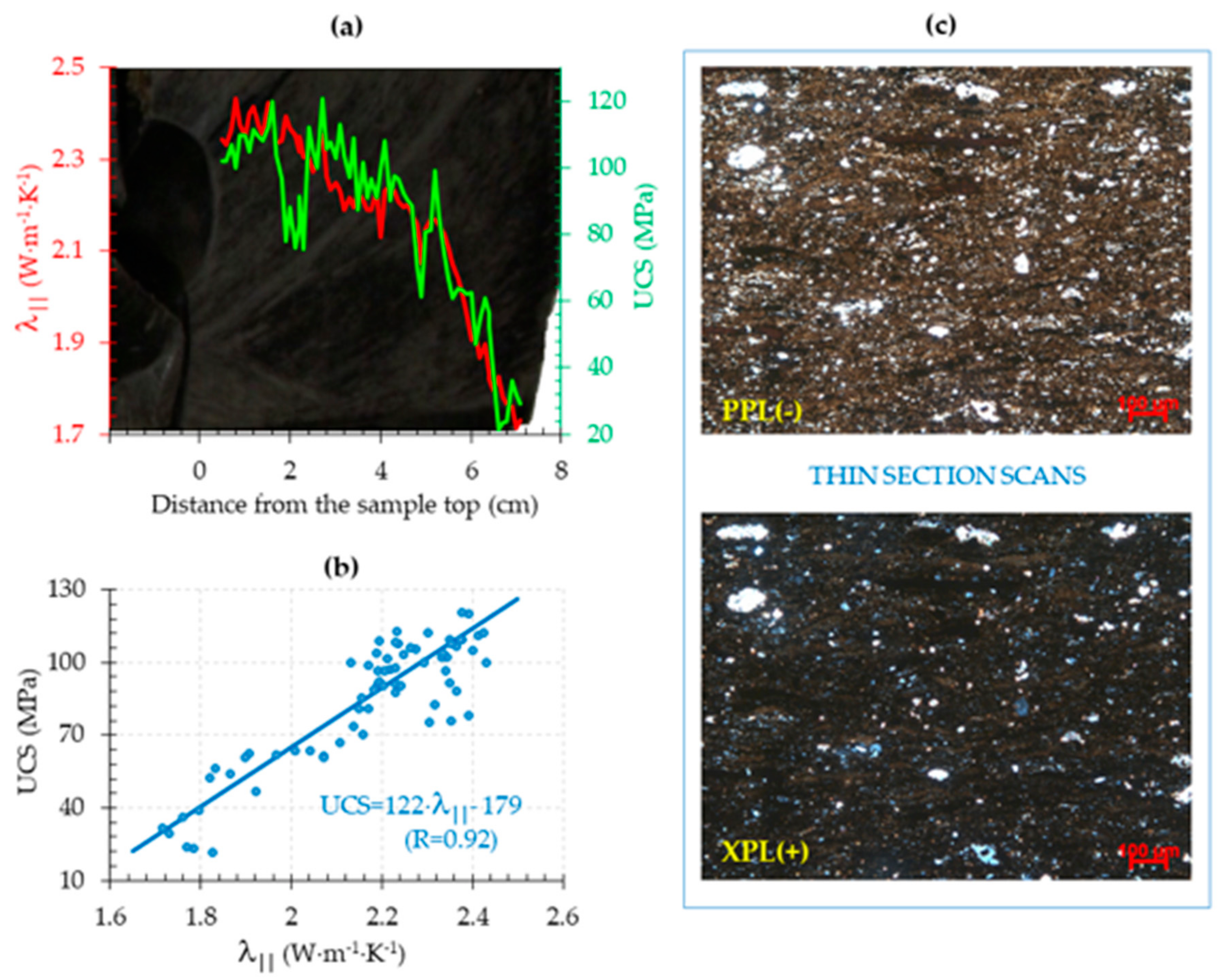
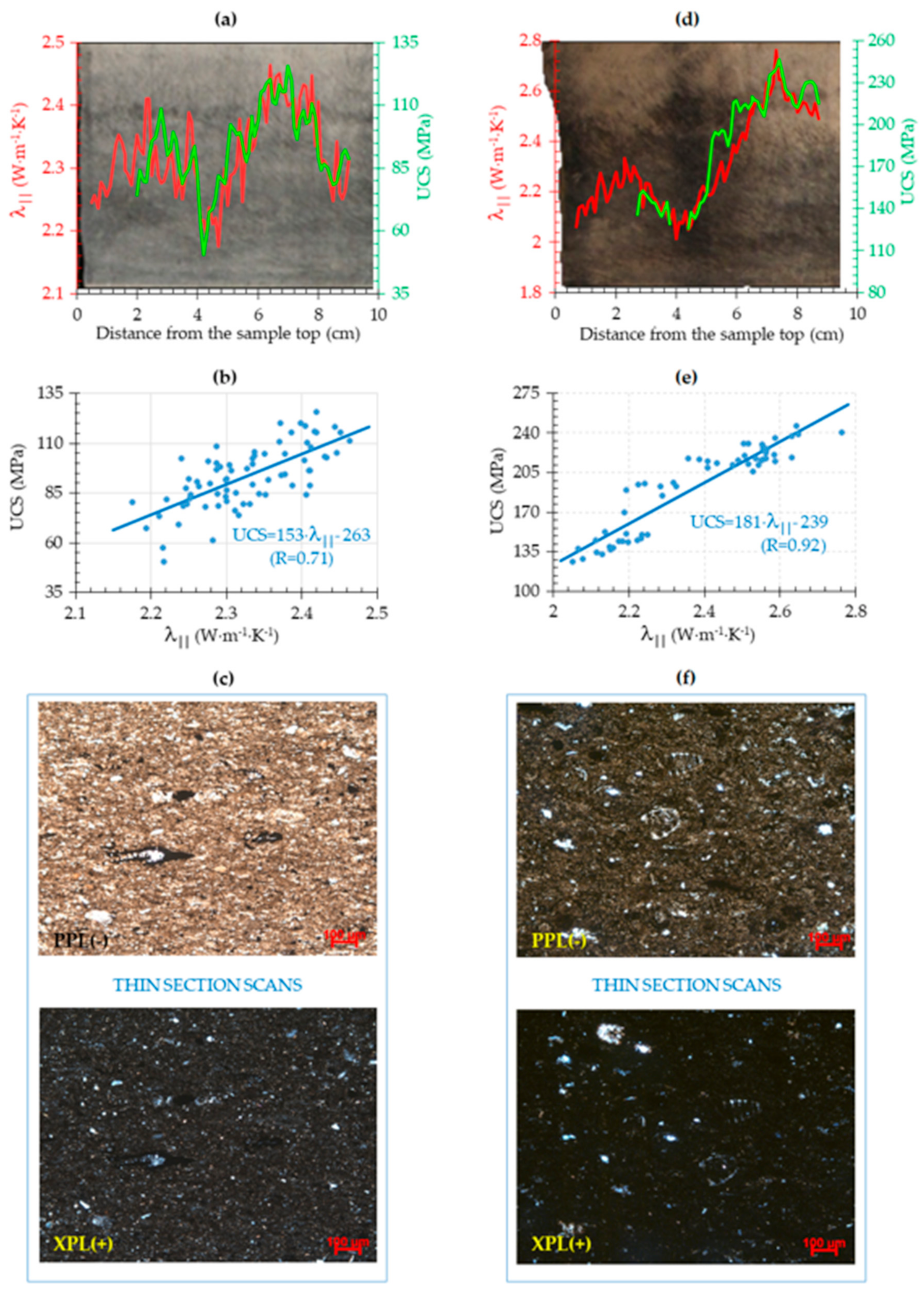

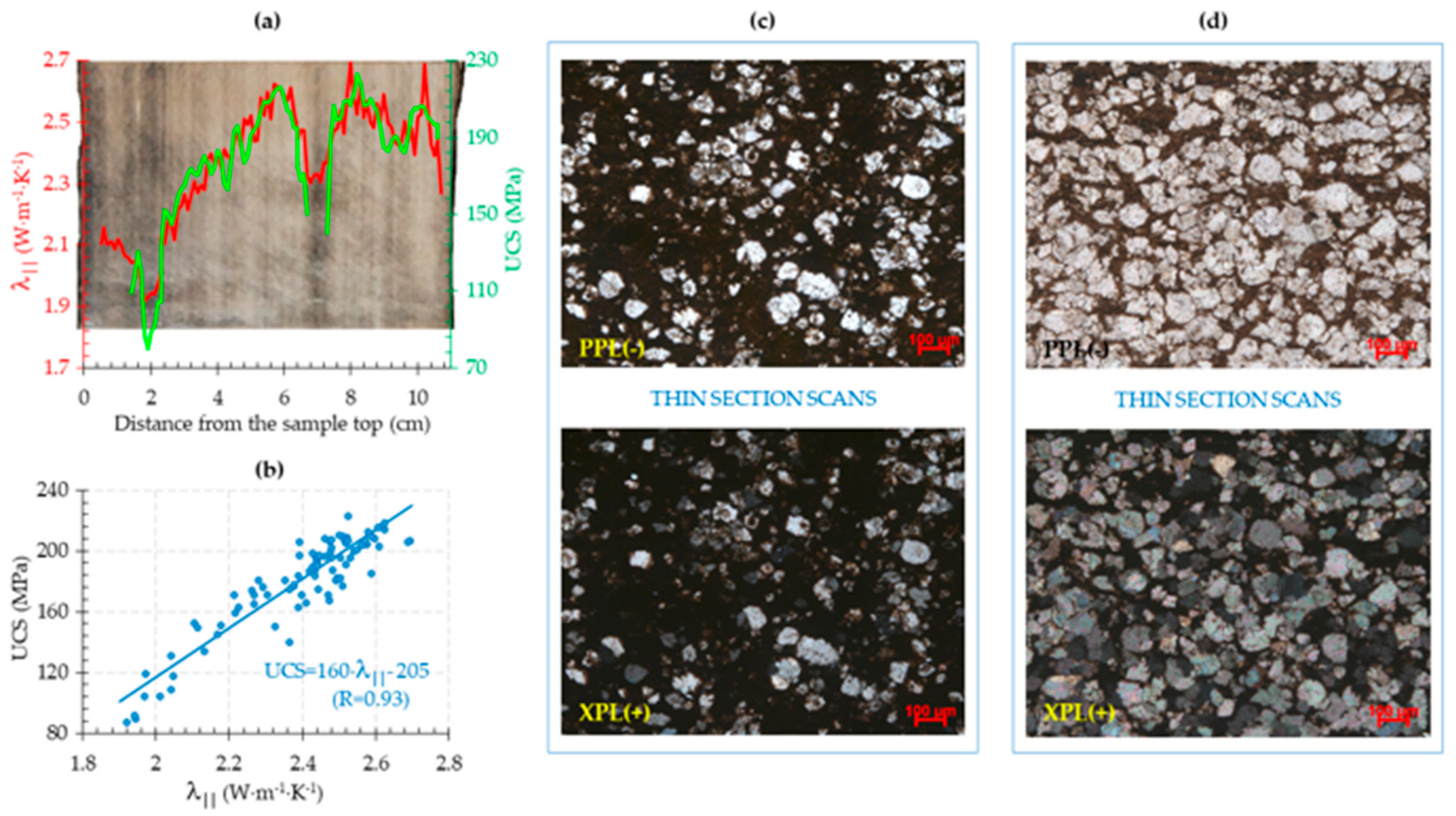

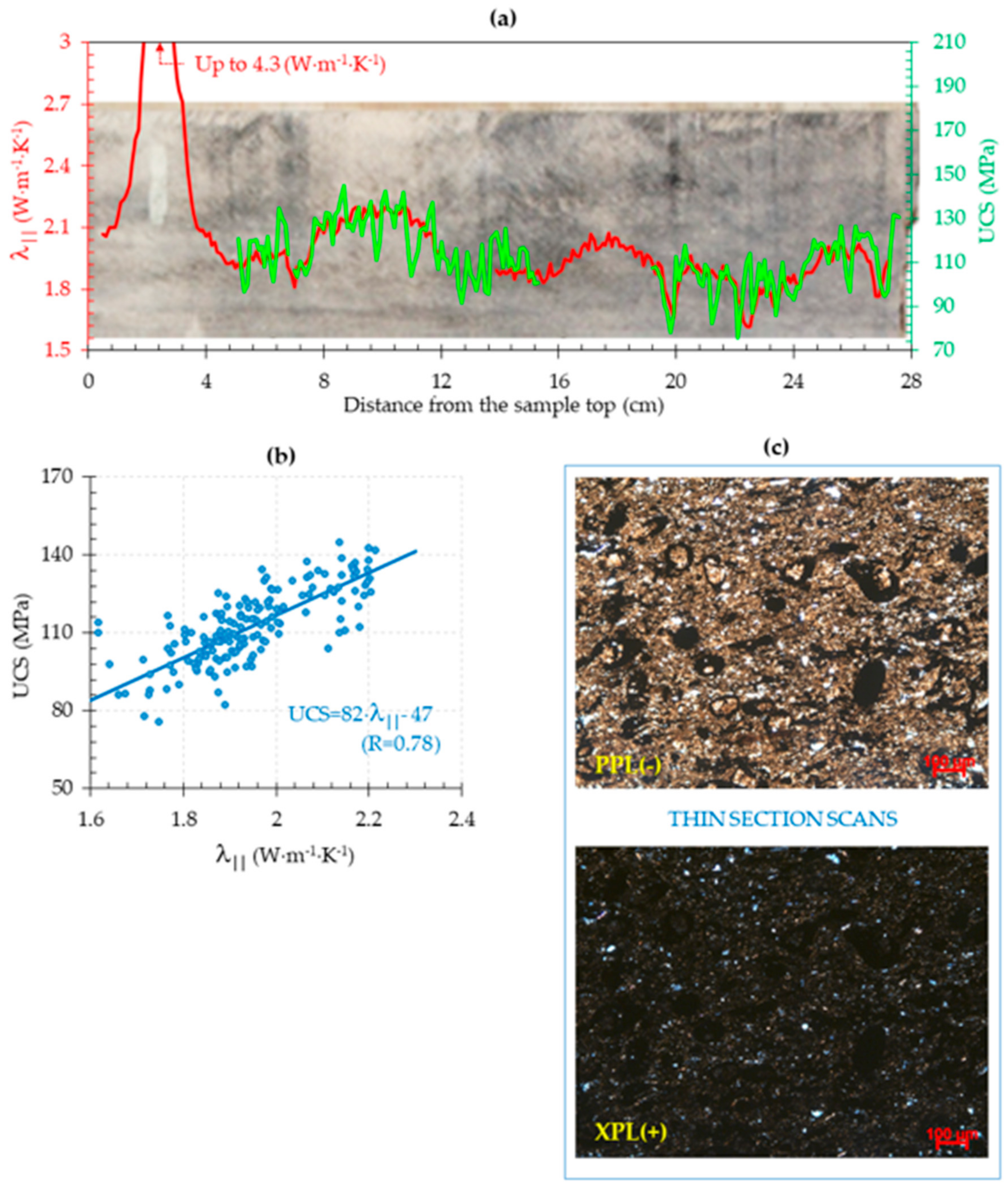
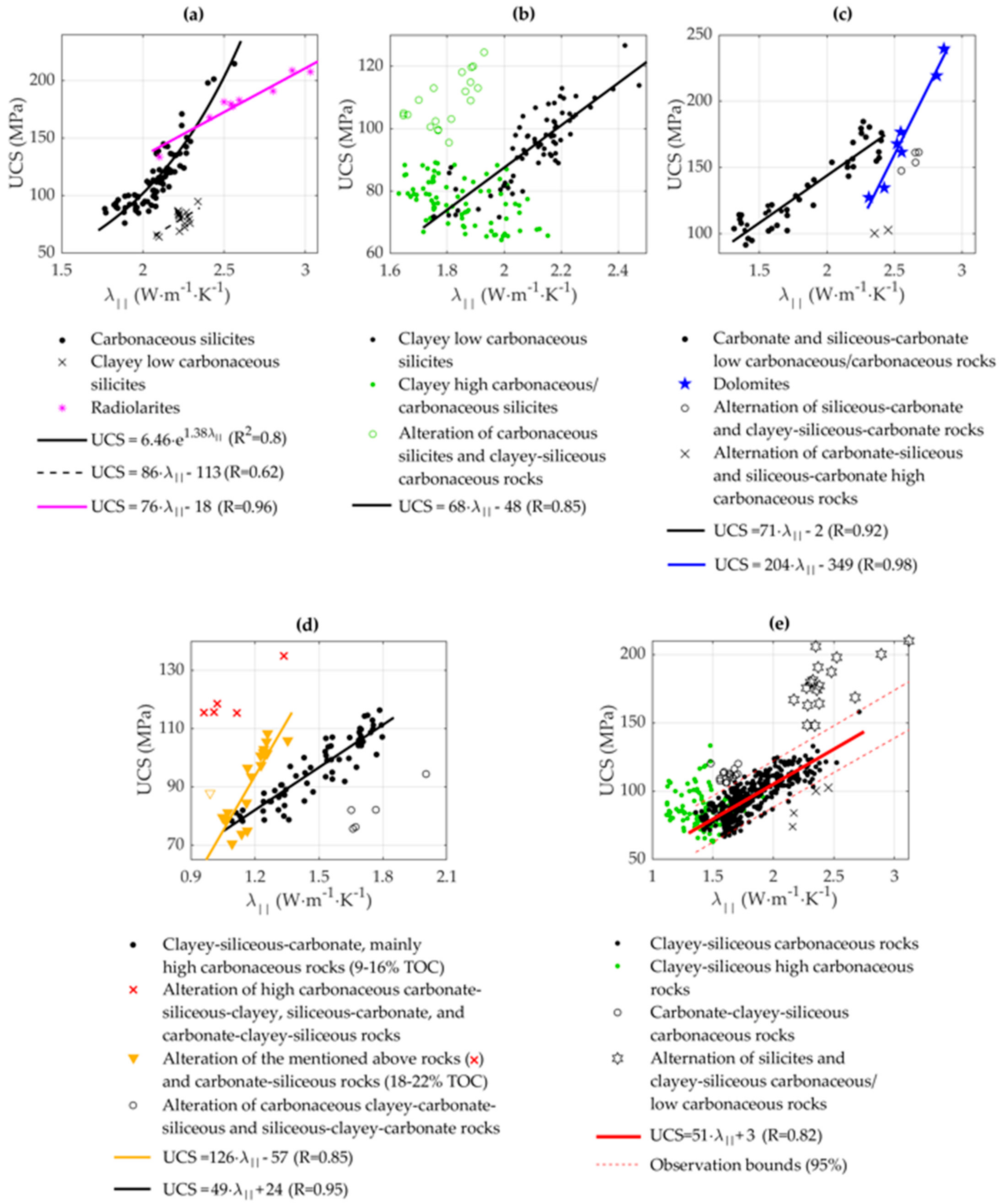
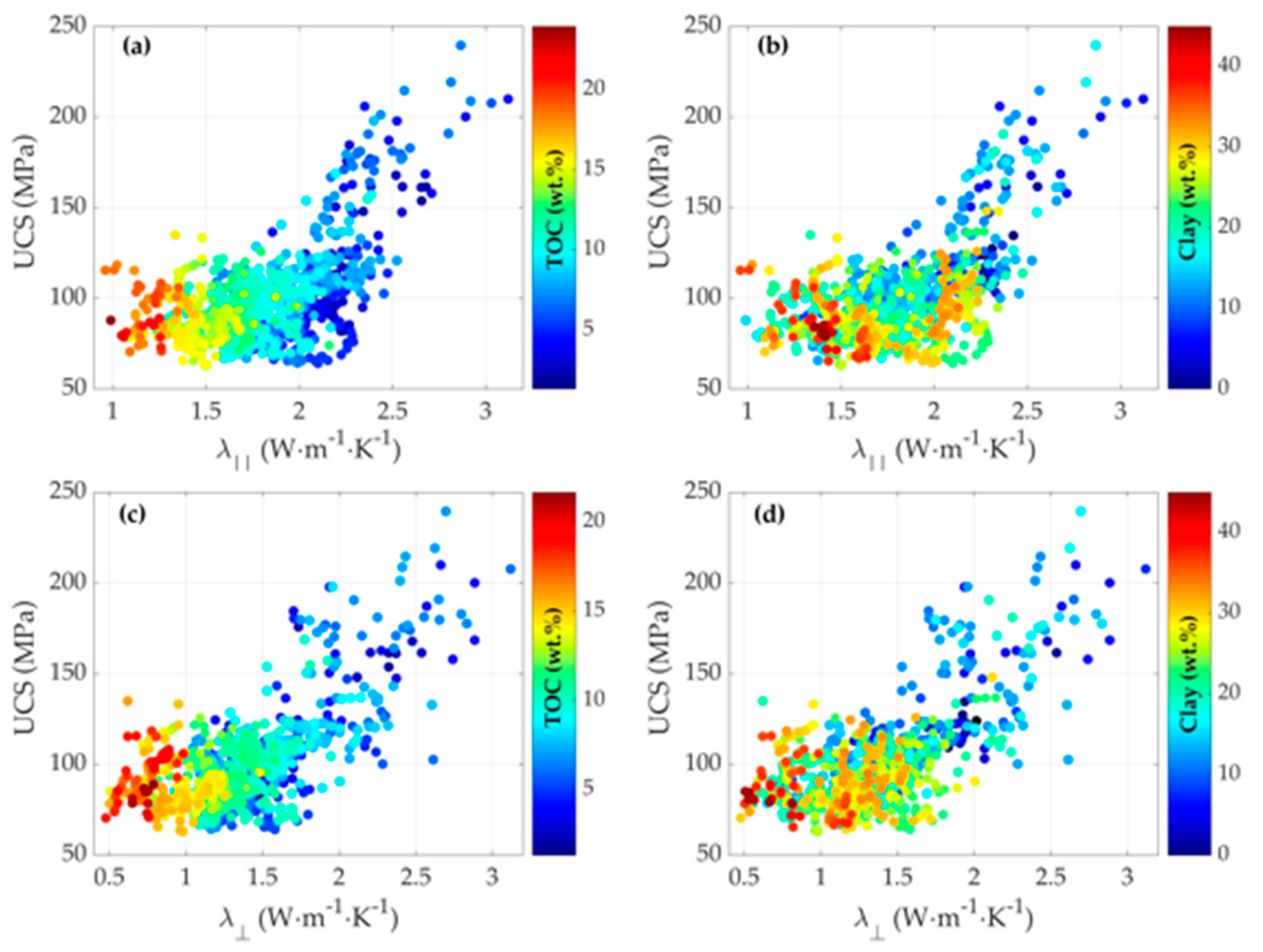

| Lithophysical Type ID | Brief Description | N of Studied * Core Samples | Percentage to All Studied Cores, % |
|---|---|---|---|
| 1 | Low carbonaceous/carbonaceous silicites | 140 | 13.2 |
| 2 | Clayey low carbonaceous/carbonaceous silicites | 202 | 19 |
| 3 | Carbonate and siliceous-carbonate low carbonaceous/carbonaceous rocks | 61 | 5.8 |
| 4 | Clayey-siliceous-carbonate high carbonaceous rocks | 132 | 12.4 |
| 5 | Clayey-siliceous high carbonaceous/carbonaceous rocks | 526 | 49.6 |
| Sample Number, Well ID | Description | Composition, % | |||||
|---|---|---|---|---|---|---|---|
| Silica Group Minerals | Clay Minerals | Field-Spars | Carbonate Minerals | Pyrite | Organic Matter | ||
| #91–92, B | Silicite (radiolarite). Skeletal remains of radiolarians 0.08–0.15 mm in size | 83.0 | 7.0 | 3.0 | 1.0 | 1.5 | 4.5 |
| #719, A | Carbonaceous silicite. Relics of partially carbonated radiolarian shells up to 0.1 mm in diameter | 74.0 | 10.5 | 3.0 | 1.5 | 0.5 | 9.0 |
| #96–97, B | Alternation of silicites and clayey-siliceous rocks | 67.8 | 12.0 | 6.0 | 0.7 | 4.5 | 9.0 |
| #888, A | Low carbonaceous clayey silicite | 61.8 | 22.0 | 5.0 | 3.0 | 3.0 | 4.5 |
| #815–816, A | Clayey-siliceous, inhomogeneously pyritized, carbonaceous rock. Relics of pyritized radiolarian shells up to 0.12 mm in diameter | 52.3 | 20.0 | 4.0 | 3.1 | 11.5 | 9.0 |
| #796, A | Clayey-carbonate-siliceous carbonaceous rock | 44.0 | 19.5 | 3.5 | 22.0 | 2.5 | 8.5 |
| Siliceous-carbonate high carbonaceous rock with relict biomorphic structure. Relics of radiolarian shells 0.1 mm in diameter replaced by carbonates | 20.5 | 8.0 | 6.0 | 50.0 | 1.5 | 14.0 | |
| #35, B | Clayey-carbonate-siliceous high carbonaceous rock. The relics of radiolarian shells are mostly replaced by calcite and dolomite | 38.0 | 16.5 | 4.0 | 23.5 | 6.0 | 11.5 |
| #118, B | Clayey-siliceous-carbonate rock. Relics of radiolarian shells are replaced by calcite and dolomite | 33.5 | 10.5 | 3.0 | 48.0 | 1.5 | 3.5 |
| Siliceous-carbonate rock. Relics of radiolarian shells (the content varies from 40% to 80%) up to 0.1 mm in diameter; all shells are replaced by carbonates | 18.5 | 7.0 | 2.0 | 71.0 | 1.5 | 0.0 | |
Publisher’s Note: MDPI stays neutral with regard to jurisdictional claims in published maps and institutional affiliations. |
© 2021 by the authors. Licensee MDPI, Basel, Switzerland. This article is an open access article distributed under the terms and conditions of the Creative Commons Attribution (CC BY) license (https://creativecommons.org/licenses/by/4.0/).
Share and Cite
Chekhonin, E.; Popov, Y.; Romushkevich, R.; Popov, E.; Zagranovskaya, D.; Zhukov, V. Integration of Thermal Core Profiling and Scratch Testing for the Study of Unconventional Reservoirs. Geosciences 2021, 11, 260. https://doi.org/10.3390/geosciences11060260
Chekhonin E, Popov Y, Romushkevich R, Popov E, Zagranovskaya D, Zhukov V. Integration of Thermal Core Profiling and Scratch Testing for the Study of Unconventional Reservoirs. Geosciences. 2021; 11(6):260. https://doi.org/10.3390/geosciences11060260
Chicago/Turabian StyleChekhonin, Evgeny, Yuri Popov, Raisa Romushkevich, Evgeny Popov, Dzhuliia Zagranovskaya, and Vladislav Zhukov. 2021. "Integration of Thermal Core Profiling and Scratch Testing for the Study of Unconventional Reservoirs" Geosciences 11, no. 6: 260. https://doi.org/10.3390/geosciences11060260







